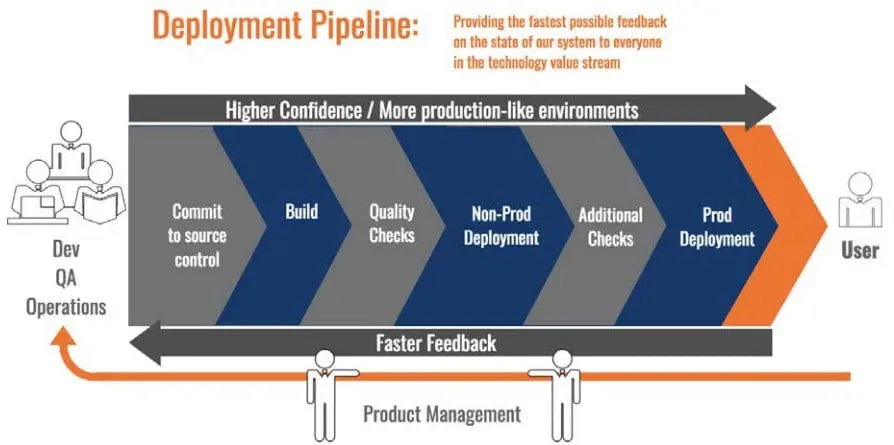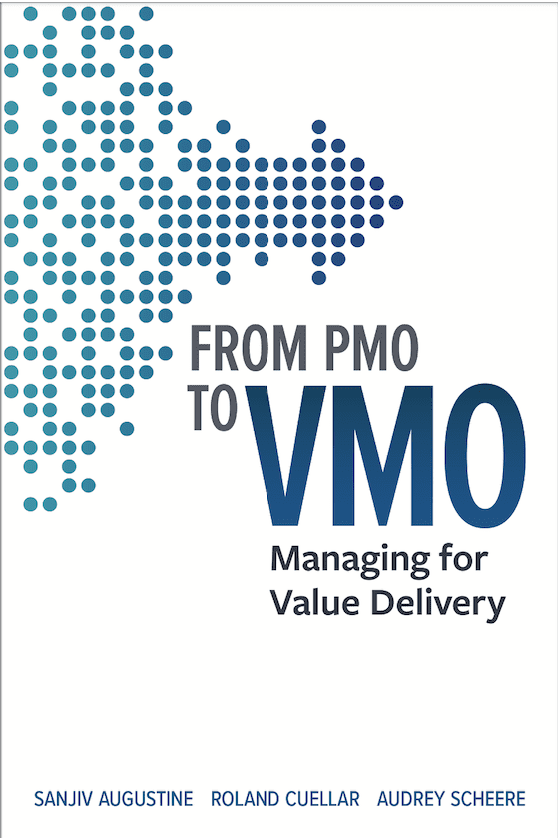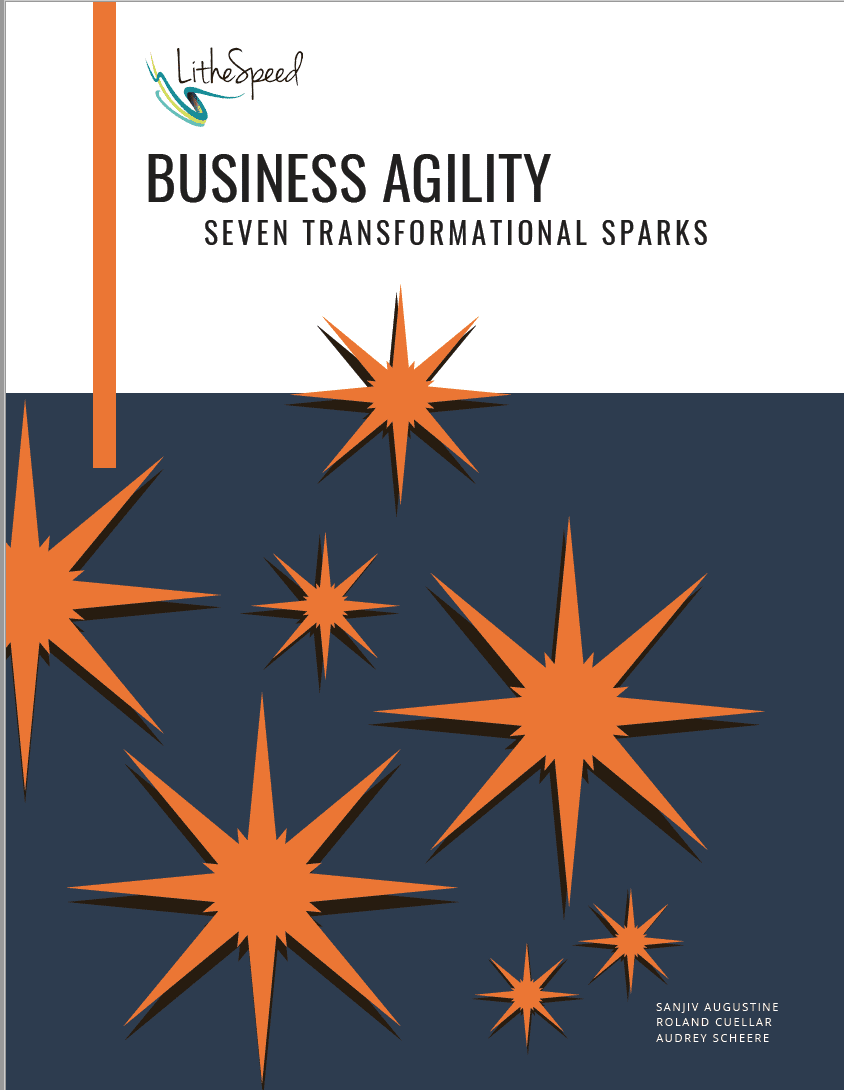Industry leaders are sparking passion and change towards business agility through three essential shifts: shifting left with Product Operating Model, shifting right with DevOps, and shifting up with Leadership and Scaling.
Sparking the shift toward Business Agility enables the whole organization to become adaptable and responsive to change. Whether or not operating model use Agile methods themselves, an Agile organization is one where all components align around value streams to allow for rapid experimentation, continuous learning, and low risk, iterative creation.
Business Agility Sparks is a flexible and customizable framework with 9 “sparks” or organizational patterns that can be implemented either separately or in combination with each other.
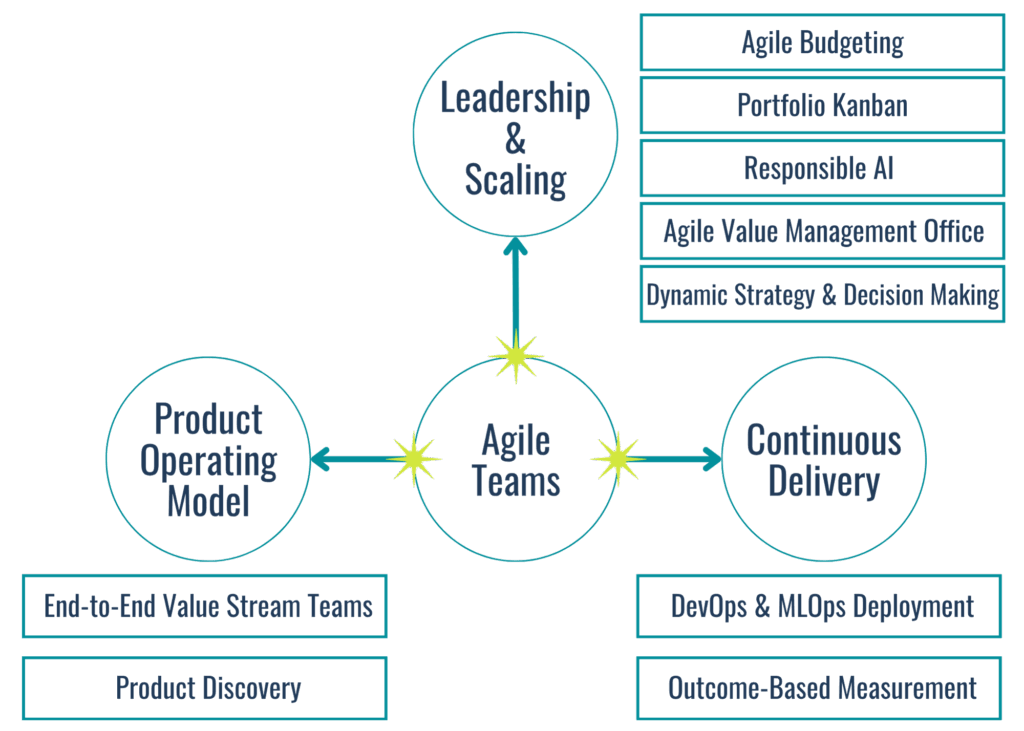
Shift-Left:
- End-to-End Value Stream Teams
- Product Discovery
Shift-Up:
- Agile Budgeting
- Portfolio Kanban
- Responsible AI
- Agile Value Management Office (VMO)
- Dynamic Strategy & Decision Making
Shift-Right:
- DevOps and MLOps Deployment
- Outcome-Based Measurement
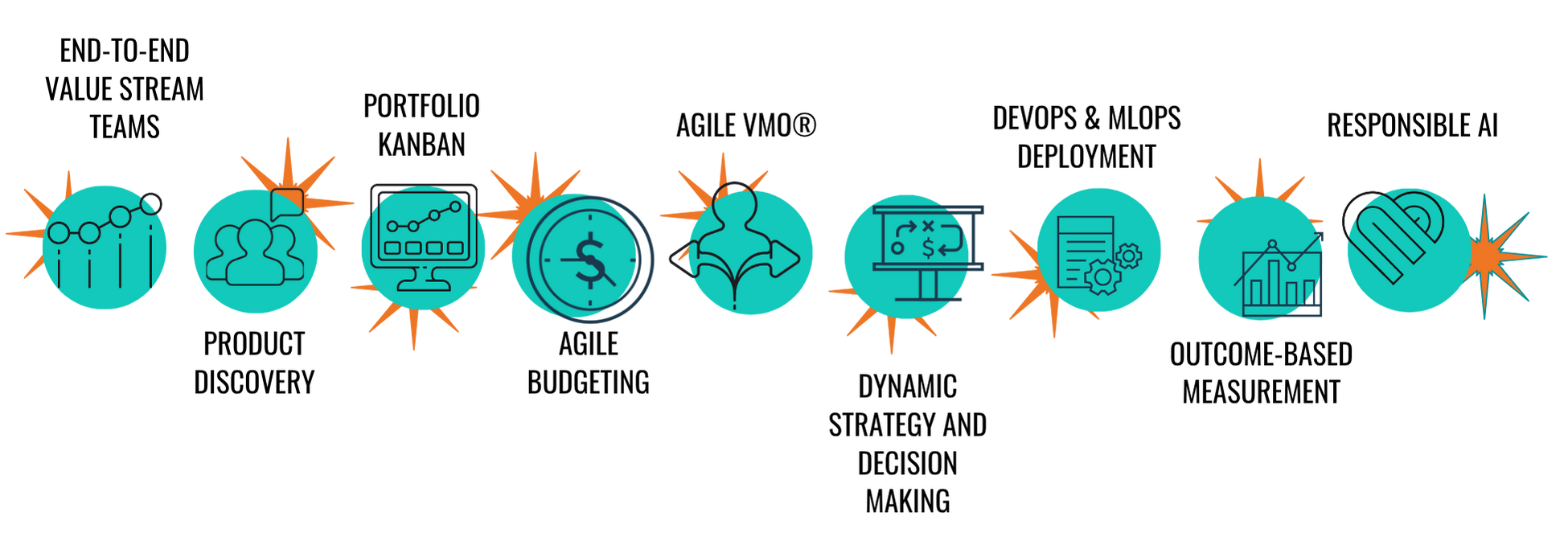
Agile VMO®
Many traditional PMOs are optimized around Project Initiation and Governance, both of which need to change if they are to adequately support business agility. Often, the PMO helps start projects. Organizations can enable Business Agility setting up an Agile Value Management Office, which focuses instead on completion of projects and flow.
Project Initiation
Governance
Governance in many organizations is built around the idea of large, infrequent changes. The expectation is that product deliveries, project releases, and business process changes will all happen infrequently and when they do, the changes will all be done at once.
For example, in most organizations, changing a production IT system involves a series of approvals and sign-offs that can take weeks or even months to accomplish.
Once again, these processes are not designed around the concept of “flow”. They are not designed to handle small, frequent changes.
To enable business agility, the governance model will need to change. It needs to encourage small and frequent changes, since those are less risky. It also needs to design smaller, lighter-weight controls that can be executed quickly and efficiently.
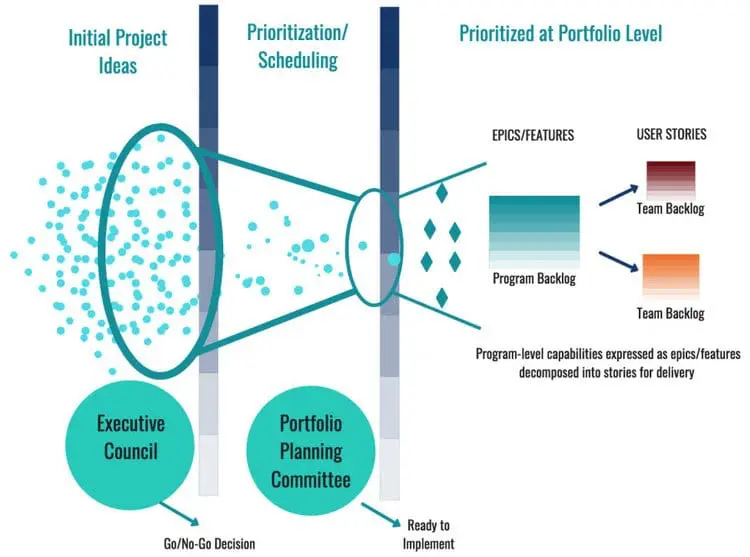
Further Resources:
Portfolio Kanban
Visual Management Systems (VMS) or “Kanban Boards” are Lean artifacts. Typically, they are large display boards that show all the work being done. They allow anyone to quickly see work in progress, understand its status, and assess what is under control and what is not.
These Kanban boards are designed to help visualize and optimize flow. Applied at the portfolio level, they help drive a continuous flow of ideas, prototypes, deliveries, revenues, and customer feedback.
Key Points
- Change the “unit of work” from projects to product features
- Align feature delivery to near-term / quarterly business goals
- Do dependency planning at the feature level and find those features that can start flow through towards “done” right now
- Use visual management systems to see the flow of work and uncover bottlenecks
- Address organizational bottlenecks
Key Outcomes
- Projects are decomposed into features and/or MMPs
- Batching is minimized so that features and MMPs are flowing independently of each other
- Business outcomes that support the strategy are being incrementally achieved on at least a quarterly basis
- The entire portfolio pipeline of work is visible from “concept to cash”
Key Metrics
- Business value achieved by quarter
- Feature /MMP throughput
- Feature/MMP cycle-time
Most organizations are not accustomed to managing for flow. Instead they tend to manage for local efficiency, people utilization, or around traditional processes. None of these techniques enhance organizational level flow or throughput.
In addition, most organizations view the “project” as the primary unit of work or unit of delivery. By batching many features and fixes into a single project and then delivering the project, the organization looses the ability to quickly deploy value to the business and to customers. Simple changes that could provide value today are delayed and eventually deployed when the whole project is completed. Customers do not care about your internal projects … they care about features and fixes. Lean is all about deploying value “as defined by customers”! The key to achieving portfolio flow is to find features and fixes that start to flow immediately towards production delivery.
Working in this manner, we can start to achieve a continuous flow of value.
An end-to-end Visual Management System is a tool to help leaders see and manage flow in the portfolio. It helps to identify bottlenecks and optimize the speed of delivery.
A simple Portfolio Kanban, as shown, can help leaders prioritize general demand, shortlist and prioritize demand, and feed a program backlog with prioritized work ready for implementation by multiple teams.
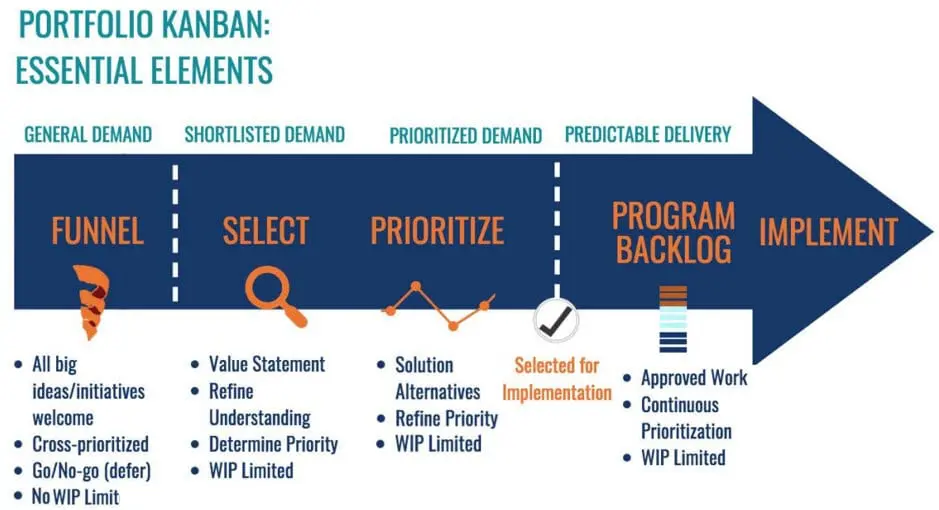
Using a Portfolio Kanban is a strategy for global rather than local optimization. Not only must teams work efficiently as they develop products, projects and programs, but portfolio managers and executives must manage work streams for the most value also. This involves prioritizing initiatives based on ROI and the cost of delay while remaining cognizant of constraints and dependencies.
Portfolio Kanban brings additional visibility to the initiatives in development (work in progress or WIP in Lean terminology) and organizational constraints. Many businesses attempt too many cross-cutting initiatives unaware of the collisions and contentions this causes. They see a business opportunity so spin up a project for it without data about it’s impact on current in-flight work. Often dependencies and constraints associated with supporting groups, poor environment provisioning, or legacy system integration limit throughput.
The result of too much work in progress and poor visibility into constraints is twofold. First everything slows down as teams engage in a complicated coordination dance of both technology-compatibility and people engagement. People try time slicing to determine what is fair and try to please or at least serve everyone. The second issue is things inevitably break. When using new, emerging technology, no one can foresee all the impacts or incompatibilities. As issues occur people on two or three projects have to stop, determine what happened, fix it and then pick up from where they were and continue.
With high levels of work in progress, determining the source of conflicts is hard and the frequency of issues is high. Momentum is difficult to build and maintain. In a culture where issues and delays are the norm it is tough to establish a mindset of accountability and reliable delivery. As a coping mechanism people establish a do-the-best-I-can mentality and do not step up to own and fix problems as frequently as we would hope for. Why would they? The next change may make it impossible, better to just do what is being asked for today.
The solution is to use Portfolio Kanban to show how the current network of initiatives creates additional work and risk. It is not a case of learning to say “No” to business requests, it is a case of using stricter sequencing based on known dependencies. Actually far more work can be delivered in a given period if the work was sequenced rather too much work attempted concurrently.
Further Resources:
- Interview: Karl Scotland on Visual Management with Kanban
- Book: David Anderson, Kanban: Successful Evolutionary Change for Your Technology Business
- Article: Leankit, Why We Need WIP Limits
Agile Budgeting
Most organizations use annual funding cycles and large projects to undertake work. These create planning cycles that are too long to adequately react to market changes.
Agile businesses budget at a higher level of abstraction. They budget around a desired business outcome instead of requirements or a highly detailed scope of work.
Agile businesses also use stable teams that stay together for extended periods of time. These teams become well-oiled machines that learn how to leverage each other’s strengths, how to communicate with each other, how to work together, and how to get things done.
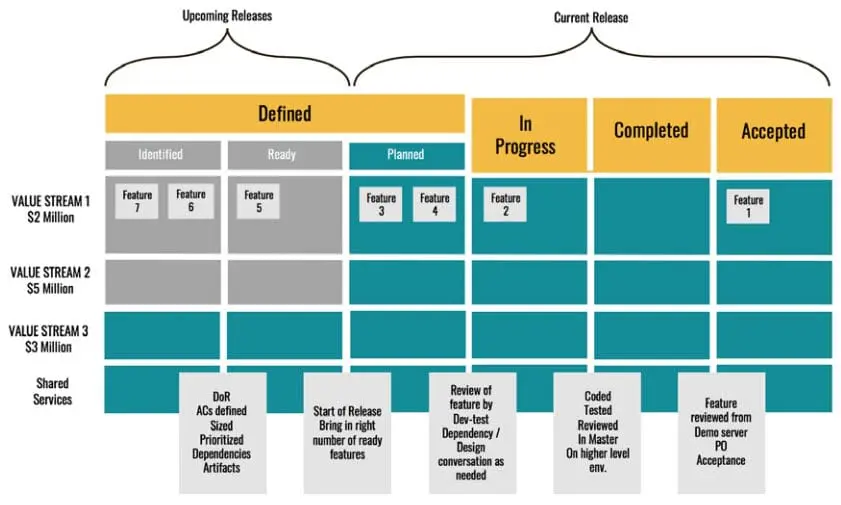
Project vs Product Lifecycles
Historically organizations used projects to fund and build products which they then handed over to sustainment groups for support. These days software is becoming more critical to the business operation of every organization. Banks are becoming IT companies with financial products, cable providers are IT companies who also offer infrastructure services along with their digital offerings. These software projects should never “finish” since they are core for customer engagement and revenue production. This is the new era of ongoing products instead of temporary projects.
The Old Way: Projects
Projects are typically estimated and funded upfront or based on a calendar year. For example, Project A may receive funding for $3M to cover its estimated 2-year development cycle, or $1.6M for this year and $1.4 for next year based on its project spend.
Traditional project teams complete development and handover to a sustainment team. This team needs to complete knowledge transfer before they can successful sustain the application through minor upgrades for the remainder of its lifespan. If major changes are required a new team is spun up, they learn about the product, make the changes and then hand it back to sustainment. Each handover and knowledge transfer takes time, loses valuable information, and reduces accountability for success.

The New Way: Products
Adopting a longer persisting product view of applications and services better matches the reality of today’s digital business. By creating a single, multidisciplinary product team for its development and sustainment we avoid the knowledge transfer and accountability losses of handovers. We also create stable, high performing teams who are accountable for a products success.
Switching from projects to products involves several core changes.
By creating stable Value Stream teams we can achieve much higher levels of efficiency and productivity. This far outweighs the supposed flexibility coming from pulling people from work and moving them around to different projects. The ‘fungible resource’ model of moving people causes teams to be in a constant state of storming/forming/norming and makes it almost impossible for them to achieve the ‘high performing’ state.
In addition, fixed Value Stream teams are much easier to manage financially. A fixed Value Stream team has a fixed burn rate. This makes estimation and budgeting much simpler.
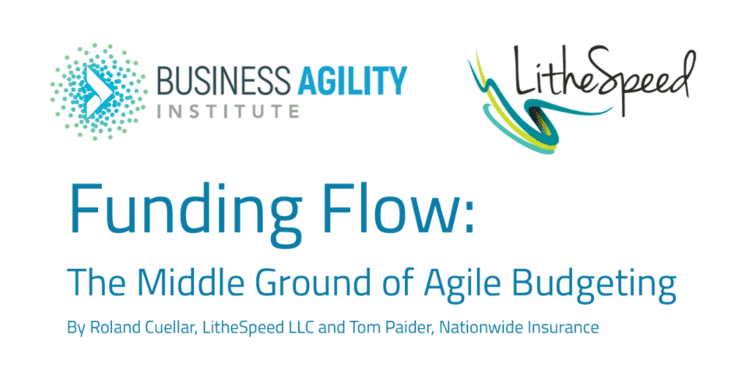
Further Resources:
- Business Agility Institute & LitheSpeed: Funding Flow – The Middle Ground of Agile Budgeting
- Blog Article: Martin Fowler, Products Over Projects
- Business Agility Institute, Finance Insights Playlist
- White paper: Emergn, Moving From Projects to Products
- Book: Allan Kelly, Continuous Digital: An Agile Alternative to Projects for Digital Business
- Book: Shane Hastie, Evan Leybourn, #NoProjects: A Culture of Continuous Value
- Scaled Agile Framework Lean Budgets
Responsible AI
Human Resources is rapidly evolving from a traditional compliance-driven function into a dynamic enabler of organizational agility and employee experience. Today, HR leaders must not only adopt agile practices—iterative, inclusive, and adaptive—but also integrate Responsible AI principles into every stage of the employee lifecycle. From hiring to career growth, performance management to communications, the convergence of Agile HR and Responsible AI enables people operations that are transparent, ethical, and value-driven.
“Talent management,” “experience management,” and “people operations” represent this evolution. The next horizon extends further: Agile HR & Responsible AI —where data-driven tools support equitable decision-making while agile methods ensure continuous adaptation to human needs.
Key Principles
- Iterative & Adaptive: Roll out HR and AI initiatives in small, testable increments to quickly identify what works and eliminate what doesn’t.
- Human-Centered Hiring & Onboarding: Use AI responsibly to augment (not replace) human judgment, ensuring that hiring algorithms are transparent, bias-checked, and supportive of diverse talent pipelines.
- Growth-Oriented Careers: Make career paths flexible and supported by AI-powered learning journeys while safeguarding against algorithmic “lock-in” or unfair progression barriers.
- Inclusive Collaboration: Create working environments—on-site, hybrid, or remote—that are augmented with AI-driven collaboration tools while maintaining human oversight.
- Targeted Local Solutions: Leverage data responsibly to personalize support for teams and individuals, without resorting to invasive monitoring or one-size-fits-all central plans.
- Continuous Feedback Loops: Integrate frequent, developmental performance conversations enriched by AI analytics, while ensuring decisions remain transparent, explainable, and free from bias.
- Transparent Communication: Blend agile transparency with AI explainability—favoring open, clear, and accessible communications over opaque processes and “black-box” algorithms.
Key Outcomes
- Higher employee engagement and happiness, supported by both agile feedback loops and responsible AI insights.
- More flexible and equitable career paths that promote cross-functional growth and remove systemic bias.
- Improved ability to attract, onboard, and retain top talent through engaging, fair, and personalized experiences.
- A culture of transparency where communication and AI-driven recommendations are explainable and trusted.
- Ethical AI use that strengthens trust and safeguards employee rights while improving organizational agility
Key Metrics
- Employee Happiness & Engagement (surveys, pulse checks, sentiment analysis with AI bias checks)
- Learning & Development Ratings (completion, application, and fairness perceptions)
- Hiring Speed & Quality (time-to-hire, candidate diversity, AI-driven bias audits)
- Retention & Career Progression (voluntary turnover, career mobility, equity across demographics)
Example Approaches
- Train HR teams in Agile + Responsible AI methods—Scrum, Kanban, bias awareness, and algorithmic accountability.
- Assess HR’s AI readiness—audit where agility and responsible automation can add value.
- Update HR vision and values to explicitly include fairness, ethics, and explainability alongside agility.
- Run story mapping workshops for both human and AI-enabled HR initiatives.
- Create a Kanban board to track HR/AI experiments transparently.
- Design engaging hiring games & AI-assisted onboarding journeys that remain bias-checked.
- Prototype flexible compensation and career progression systems that use AI responsibly to forecast skill needs.
- Decentralize HR—empower local teams with agile + AI dashboards to self-manage and adapt.
- Use value stream mapping to spot waste in HR processes while checking where AI may add efficiency without sacrificing fairness.
- Experiment with flexible schedules supported by AI-enabled workforce analytics, ensuring employee well-being remains paramount.
- Craft an “advice process” where AI insights inform but do not dictate decisions.
- Implement micro-recognition systems that encourage fairness and inclusivity.
- Pulse teams regularly—using AI tools responsibly for trend analysis but always with human review.
Further Resources:
- Business Agility Institute, People, HR and Talent Insights Playlist
Dynamic STrategy & Decision Making
Many organizations are organized by an annual planning and budgeting cycle. They set financial targets for the year, set strategy for the year, and launch projects for the year. This assumes that, through detailed upfront analyses, we can predict the future accurately enough to choose a clear strategic direction a year or more in advance. Unsurprisingly, in many of these organizations, delivery also happens yearly. It is common to see large organizations with 200+ day cycle-times for the delivery of larger programs and strategic initiatives.
As organizations move toward Agile, many accompany a new way of working with modern and trendy management structures, such as the adoption of Holacracy or enterprise-wide self-management. Just because organizations need to be adaptable does not mean they cannot have a long term strategy or business plan.
In fact, the most Agile enterprises are grounded in a shared purpose, driven by a leader with a razor-sharp vision and an unwavering set of principles. Rather than just go with the flow, Agile organizations make decisions based on data, and build dynamic strategy through continuous measurement, learning and responding.
Details:
Moving to shorter strategic cycles is one of the most powerful things that leaders can do to make their organizations become more Agile. Agile businesses might set quarterly goals, and have small quarterly strategies that make incremental progress towards those annual goals. Delivery groups then create smaller, shorter efforts that show measurable progress towards the strategy.
Each quarter, the leadership team assesses which targets are being met and which ones are not. By this time, competitors may launch new capabilities, customers may demand new services, our own financial position may have shifted, and we can adjust the next quarter’s strategy based upon the new information. No longer are we locked into year-long gambles, year-long spending, and a year-long wait for results.
Decision Making Velocity
Agile businesses require a more dynamic, and decentralized decision making process. One that works fast and efficiently, and can create good and credible decisions sometimes based upon incomplete data. Additionally, leaders need to build their team members’ capability to make decisions on their own, without the leader herself being a bottleneck.
In Principles: Work and Life, founder of the mammoth hedge fund Bridgewater Associates Ray Dalio shares guiding principles that have been the cornerstone of the growth of himself and his company. In his straightforward list of rules, readers find a rock-solid path to rapid, decentralized decision making.
According to Dalio, to make decisions effectively one must learn, simplify and decide well. A “radically open-minded” leader weighs choices based on advice from people with “believability,” and decision making becomes a process guided by principles. To Dalio, believable people have repeatedly and successfully accomplished the thing in question — who have a strong track record with at least three successes — and have great explanations of their approach when probed.
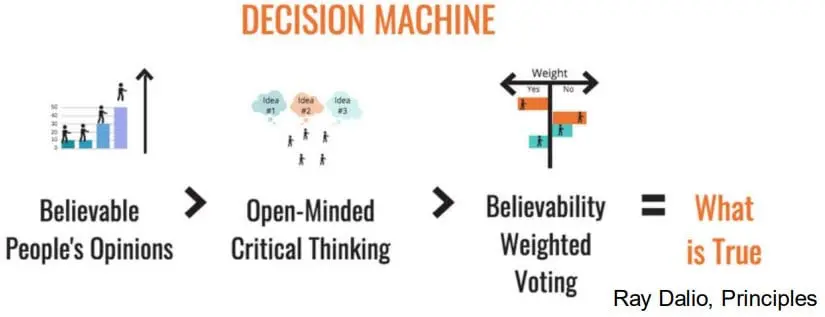
The leader’s job then is to develop decision making capability, ensure that decisions are made through open and transparent critical thinking and discussion. Also that the decisions made by people with proven decision making capabilities are weighted more than decisions made by people without experience of a track record or believable opinions.
Product Discovery
Over the past decade, organizations have blended Lean Startup® techniques with Agile delivery, evolving toward models like Dual-Track Scrum, where discovery and delivery operate in parallel. This allows teams to validate business ideas early while delivering working product increments.
Yet, many enterprises still rely on traditional projectized funding models that drive waterfall-style planning. These models create pressure to lock in scope, schedule, and budget upfront, leading to wasted effort, reduced innovation, and features that don’t deliver value.
LitheSpeed’s Product Operating Model (POM) implementation advances beyond this project-centric approach by integrating Product Discovery, Design Thinking, and Agile Delivery within a value-driven governance framework. The POM establishes end-to-end product accountability, spanning from strategic intent to customer impact, and enables business agility at scale.
Key Elements of the POM Approach to Product Discovery
- Strategic Alignment & Value Streams: Work is organized around value streams and products, not projects. This ensures continuous alignment between enterprise strategy and customer outcomes.
- Dual-Track Flow: Discovery and delivery run side by side—discovery fueled by Lean Startup experimentation and Design Thinking, delivery powered by Agile execution and continuous integration.
- Deferred Commitment: High-level scope and intent are aligned early, but detailed scope decisions are made at the last responsible moment, ensuring flexibility and reduced waste.
- Continuous Customer Validation: Lean Startup style experiments validate business ideas, while Design Thinking ensures solutions are desirable, feasible, and viable.
- Adaptive Governance: Rather than locking in upfront plans, the POM leverages rolling-wave planning, dynamic funding, and outcome-based metrics to guide investment.
- Product Trio Decision-Making: Product, Design, and Engineering leaders collaborate closely, ensuring that trade-offs are made holistically, balancing customer experience, technical soundness, and time-to-market.
Outcomes of the POM Approach to Product Discovery
- Faster Time-to-Value: Delivery pipelines aligned to value streams reduce lead time and accelerate feedback.
- Higher Relevance & Impact: Discovery-driven solutions ensure products solve real customer problems rather than delivering unused features.
- Innovation at Scale: Continuous experimentation enables organizations to invest in bold ideas without committing prematurely to unproven bets.
- Transparency & Trust: Adaptive governance, lean funding, and clear outcome metrics replace rigid project controls with visibility into value delivered.
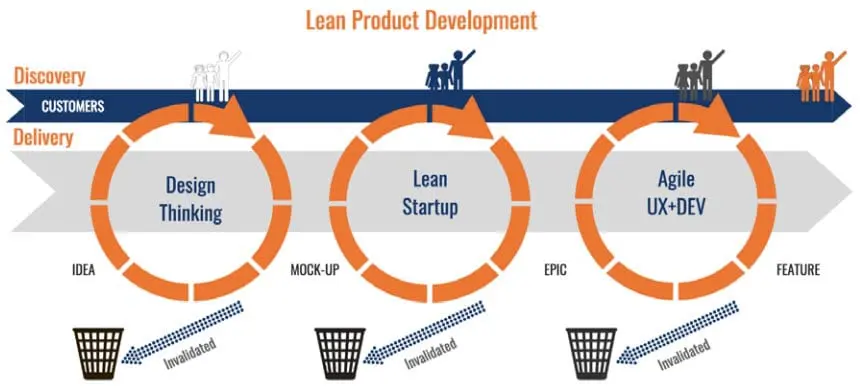
End-to-End Value Stream Teams
Agile businesses use networks of End-to-End Value Stream Teams to deliver improved customer experiences. They operate as full-lifecycle, entrepreneurial groups that rapidly adapt to changing needs.
These Value Stream Teams extend the notion of ‘stable agile teams’ across the full range of activities that it takes to define, build, and deploy a solution. In a sense, they are a company within a company that takes full ownership and accountability for its product.
These entrepreneurial units are able to move with speed and effectiveness because they do not need to navigate ten different silos and functions. They have all the skills and resources needed to deliver, right now.
Value Stream Teams operate using minimal, sufficient-to-purpose Digital and Portfolio Management and governance. This includes long-term considerations like strategy and road-maps and short term considerations like metrics, investment, measurement and reporting.
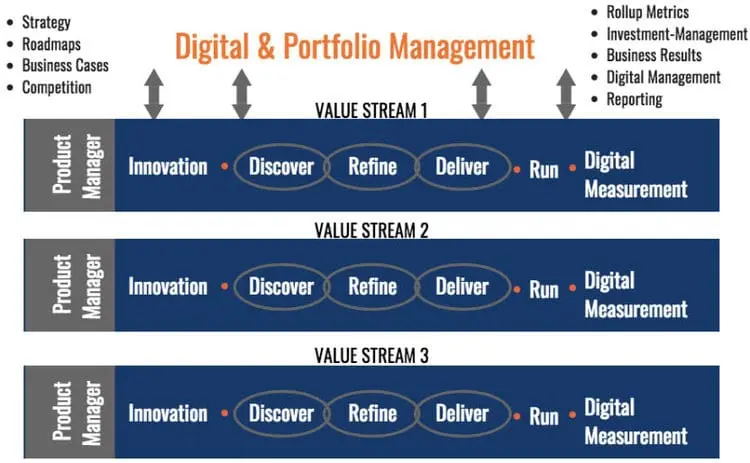
Implementing Value Stream Teams
Establish Cross-Functional Agile Teams if they do not already exist
Establish Leadership Representation from Business Groups comprised of people from each silo within the value streams.
Map Value Streams to identify opportunities for improvement, customer
experiences, and the business units needed to deliver core business products and services.
Define End-to-End Team(s) within pilot journeys with small, cross-functional agile teams
“Shift-Left” to business including units such as business planning, marketing and legal
“Shift-Right” to include operational and sustainment units
Pilot End-to-End Delivery Pipeline with executive support and active coaching assistance
Outcome-Based Measurement
Long term success combines technical delivery excellence with customer service and responsiveness. Development cannot be successful independent from customer experience. Nor can operations be a success without seamless integration with development releases and customer feedback/requests. Today Agile businesses link the three domains of Development Success, Operational Success, and Customer Experience success through Outcome-Based Measurement.
DevOps automation techniques link the development, release, and customer feedback disciplines that enable outcome-based measurement. This includes business success deploying products and services through all the intermediate operational stages to customer success and feedback.
Focusing on outcomes (goals) rather than outputs (traditional metrics) allows us to achieve the true benefits of an integrated lifecycle without being distracted by local optimizations or unintentional gaming of the metrics. By optimizing the whole we can achieve greater customer satisfaction and loyalty and higher levels of feature throughput and efficiencies.
We start by learning the outcomes each segment desires. The image below shows common outcome based measures for each stage of the development and operational life-cycle.
Viewing the components integral pieces in an unbroken chain of services allows Agile businesses to optimize for throughput, quality and service.

DevOps & MLOps Deployment
DevOps principles and practices encompass the entire technology value stream, enabling IT groups to deliver value quickly, reliably, and securely. By improving flow, automating feedback, and breaking down silos, DevOps lays the foundation for true business agility. Every step in the value stream produces feedback that is radiated back to teams and business stakeholders, enabling rapid insight into how customers interact with products and services.
MLOps (Machine Learning Operations) extends these same principles into the AI/ML lifecycle, where experimentation, model training, deployment, monitoring, and retraining must happen continuously and responsibly. Just as DevOps bridges Development and Operations, MLOps bridges Data Science, Engineering, and Operations, ensuring that AI-powered capabilities are integrated safely, ethically, and at scale.
Key Practices
- DevOps: Version control, continuous integration/delivery (CI/CD), automated testing, loosely coupled architectures, low-risk releases, and telemetry.
- MLOps: Data versioning, reproducible pipelines, automated model training & validation, bias detection, model deployment, monitoring for drift, explainability, and retraining loops.
- Shared Foundation: Both rely on collaboration across silos, automation, rapid feedback, and adaptive governance to ensure outcomes are achieved.
Business & Employee Benefits
- Faster, Safer Delivery: Features and ML models move from concept to production more quickly, with lower risk.
- Improved Quality & Innovation: Continuous feedback ensures both software and models remain relevant, accurate, and high performing.
- Employee Engagement: Breaking silos between developers, operations, and data scientists fosters collaboration, learning, and ownership.
- Resilient Systems: Automated pipelines for both code and ML models reduce human error, streamline compliance, and enable rapid response to change.
Outcome-Based Measurement
DevOps and MLOps enable organizations to track progress and value delivery at every stage:
- Customer Success: Engagement, adoption, and satisfaction with digital and AI-enabled services.
- Business Success: Measurable outcomes such as revenue growth, cost reduction, and time-to-market improvements.
- Intermediate Indicators: Deployment frequency, lead time for changes, model accuracy, fairness, drift detection, and recovery times.
